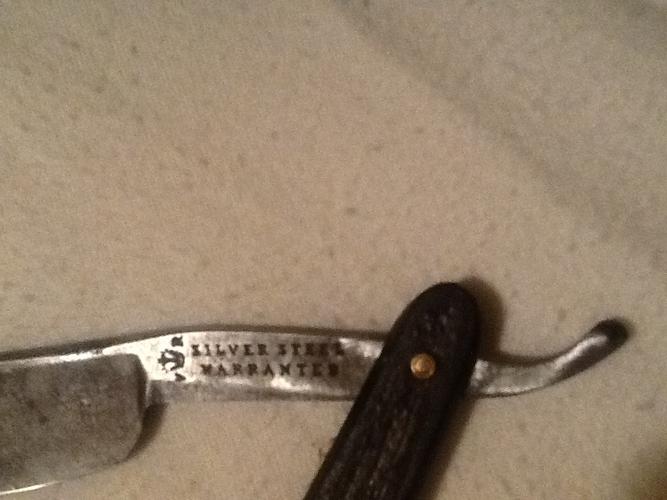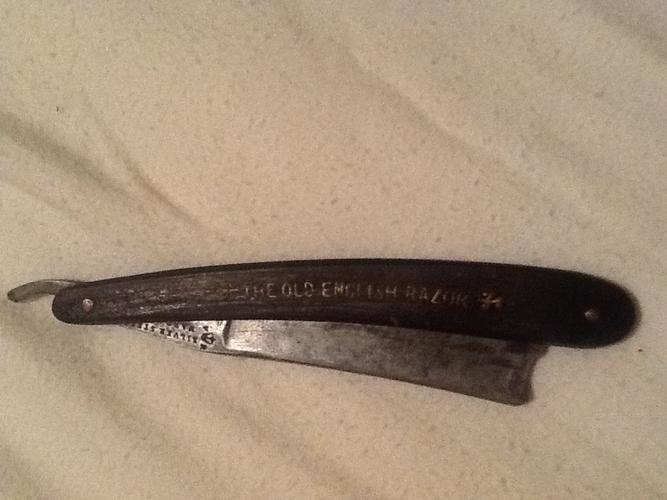Results 1 to 8 of 8
Thread: Maker origin: Stampmark VR
-
10-07-2012, 08:17 AM #1Member

- Join Date
- Apr 2010
- Location
- Abbotsford B.C
- Posts
- 89
Thanked: 5 Maker origin: Stampmark VR
Maker origin: Stampmark VR
Hey guys,
So I picked up a wedge about 6 months ago. Put it on the shelf until I had time for it. Just wondering if anyone else has come across these
Handle: dark bone with gold lettering "The Old English Razor"
Blade: "Silver Steel
Warranted"
Perpendicular to silver is a crown stamped with a V and R on either side.
no country.
It has a barber notch.
I will try uploading a photo, though it seems our website isn't a fan of Apple products.

-
10-07-2012, 04:35 PM #2

The scales are probably horn and not bone, simply because it was the more commonly used material, especially for pressed designs.
The V(crown)R mark indicates that it was made during the reign of Queen Victoria (V.ictoria R.egina).
The Silver Steel and Warranted were fashions, the way Titanium and Carbon Fiber are these days, and they suggest (though it's a very fuzzy kind of suggestion) that the razor was made in the earlier part of Victoria's time on the throne, so 1840's to maybe 1860.
'The Old English Razor' is another clue, and another vague clue. The trademark was used by a lot of people and may have fallen into generic use at some point. If memory serves it was owned by John Barber in the 1820's, but used also perhaps by Isaac Barber (there was litigation). Much later it was used by Joseph Wostenholm (NOT George Wostenholm).
Scales aren't the greatest way of judging who made a razor when, though. Men regularly worked the streets of major cities doing razor repairs in the mid-1800's. Mostly they reground blades that had been honed too much or too badly, but (and I am assuming here, so please don't assume this is truth) I would guess they also did repairs like replacing broken scales.
The total lack of speculation on who made the razor is because that's just not very knowable. None of those marks are specific to a single maker. Possibly, at some point, a maker's stamp or etching was on the blade, so you might examine that more closely and in different lighting conditions, but most likely it's one of many razors turned out by the Sheffield razor industry in the middle of the 1800's that did not bear any originating mark.-Zak Jarvis. Writer. Artist. Bon vivant.
-
10-07-2012, 06:22 PM #3Member

- Join Date
- Apr 2010
- Location
- Abbotsford B.C
- Posts
- 89
Thanked: 5
Thanks Voidmonster,
Sorry, don't know what I was thinking typing bone. I also felt this is a pretty generic razor, but I'm glad you were able to shed some light as to a rough time frame it came from.
If I recall it was the later 1800's that makers had to put the origin of country/region on their blades, but this is what I'm trying to remember what another senior member here told me (JimmyHad maybe?)
I guess now I need to decide to either restore this as is, or fabricate new scales.
Thanks again!
-
10-07-2012, 06:48 PM #4

The country of origin stamps are sometimes helpful, but if the object was not intended for export, it might not have the stamp. The date that began was 1891. Here's a page with a lot of information about it.
I have a Fenney 'Tally Ho' razor with bone scales that I thought were horn for the longest time. To my eye, they look almost indistinguishable from some varieties of translucent horn. It wasn't until I rubbed it with my thumb that I noticed it smelled like bone instead of horn. It can be surprisingly easy to mistake them!
Personally, I would fix up those scales. I'm a big fan of horn as a scale material though. It's very easy to repair and maintain. Really though, it's personal preference. Especially when dealing with an unmarked razor like that, the tenuous history it has argues much less strongly for preservation. Being a useful tool will preserve that history better than attempting to restore to an unknowable original state.-Zak Jarvis. Writer. Artist. Bon vivant.
-
10-07-2012, 06:49 PM #5

IIRC it was from 1892 (or maybe 1890?) the country of origin had to be stamped.
Edit: Sorry, 1891....
Here's a similar razor I restored a while back: http://straightrazorpalace.com/custo...back-life.htmlLast edited by Zephyr; 10-07-2012 at 06:52 PM. Reason: Corrected before posting...
Need help or tutoring? Check out the .
Rune
-
10-07-2012, 07:08 PM #6Member

- Join Date
- Apr 2010
- Location
- Abbotsford B.C
- Posts
- 89
Thanked: 5
Zephyr you did a great job with that. I'm now inspired to save this one.
Voidmaster : "Being a useful tool will preserve that history much better than attempting to restore to an unknowable original state."
I agree entirely.
-
10-07-2012, 11:44 PM #7
-
10-08-2012, 08:46 AM #8Senior Member



- Join Date
- Apr 2008
- Location
- Essex, UK
- Posts
- 3,816
Thanked: 3164
Ignore any advice telling you that you can date a razor by 'hallmarks' - you cannot. The blades are made from steel - a base metal, and only precious metals (gold, silver, platinum...) are hallmarked. The hallmark is applied by an Assay Office - not a cutler. Cutlers who make/made items from silver (eg spoons, fruit knives) had to send every batch to a government run Assay Office to be assayed (checked that they are made of a precious metal) and stamped. Each city had its mark of origin - eg an anchor for Birmingham - but an anchor on a steel razor, for instance, is not an assay mark and therefore no guarantee that the item was made in Birmingham, as some of the posts in the thread linked to seem to suggest. The only time they may help is if the scales are made of silver, then the location of the Assay Office (eg Birmingham) can be seen from the anchor device, and the year of assay from the date mark. I say 'may help' for a number of reasons:
1. Because a London-made item can be sent to the Birmingham Assay Office, for example.
2. If it is the scales or anything other than a blade that has the Assay Mark then the age/location data will only definitively apply to that item, not to the blade, and
3. Items can have been made quite some time before thay are sent to an Assay Office.
Sovereigns marks are another matter, but in very few cases they give a broad range of dates.
I think Voidmonster's posts just about sum it up - all we have are broad hints. There is nothing to definitely identify the maker. All you know for sure is that it was made during the reign of Queen Victoria - a particularly long time!
Regards,
Neil


 4Likes
4Likes LinkBack URL
LinkBack URL About LinkBacks
About LinkBacks






 Reply With Quote
Reply With Quote


